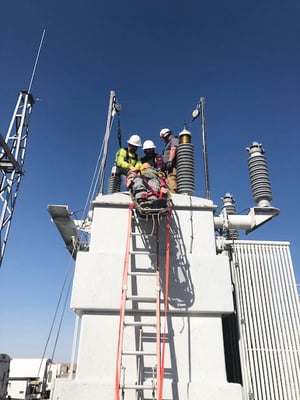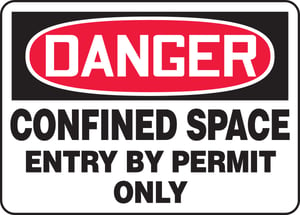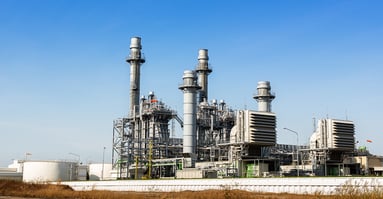Unique Hazards in Power Industry Rescue
The power industry has its unique hazards – especially when it comes to rescue. Whether it’s generation, transmission or distribution, the hazards can be formidable in an emergency. Highly energized equipment, work at height, confined spaces, fall hazards, remote operations and limited workforce – these are just a few of the challenges that face workers (and rescuers) in the power industry.
 Fortunately, developments in modern, lightweight equipment along with specialized rescue techniques have made rescue quicker, safer and more efficient than ever. We have found that applying these technical enhancements to the power industry can make all the difference in a confined space or high angle emergency. Tools and techniques that are easier to learn (and use) will pay off in the long run.
Fortunately, developments in modern, lightweight equipment along with specialized rescue techniques have made rescue quicker, safer and more efficient than ever. We have found that applying these technical enhancements to the power industry can make all the difference in a confined space or high angle emergency. Tools and techniques that are easier to learn (and use) will pay off in the long run.
To learn more about the special hazards inherent to the power industry as well as potential rescue solutions – we interviewed several of our Roco Industrial Services Managers and Lead Instructors, who have spent thousands of hours in industrial facilities and power plants across the country.
Why do confined spaces pose particularly hazardous environments in the power industry?
First of all, there’s the volume of confined spaces in a typical power plant; they can be numerous. These spaces include boilers, turbines, vaults, cooling towers, transformers, penstocks and more – many are permit spaces requiring complex technical rope rescue operations. Then, there are ever-present electrical hazards plus all of the many other hazards found in a working plant. There’s no doubt – any rescue service must be on their A-game when performing rescue operations in a power plant. Hazard assessments and detailed preplanning become crucial functions in order to perform safe and effective rescues. Having a rescue service that can mitigate the inherent hazards (atmospheres, electrical, engulfment, entrapment) is key to a successful rescue versus a body recovery.
For rescue training purposes, what are some practical scenarios used to prepare workers and/or emergency responders?
Practice scenarios are developed based on the anticipated rescue applications for the team. The following are a few examples of scenarios we would use in training or practice drills. In certain cases, complex confined space rescues may be included, which require a trained and equipped technical rescue team. Remote operations may also apply in which an employee may be required to self-rescue or rescue a co-worker with limited equipment.
- Power Generation - Permit Required Confined Space and Rescue from Fall Protection
- Power Transmission - Tower, Pole Top, Bucket Rescue
- Power Substation - Transformer Top, Permit Required Confined Space, Suspended Worker
- Power Distribution - Tower, Pole Top, Bucket, Trench/Excavation, Utility Manholes/Vaults
What about special regulations for the power industry – are there unique regulations and standards for rescue operations?
For rescuers, OSHA 1910.146 Permit-Required Confined Spaces remains the guiding regulation. OSHA 1926 Subpart AA applies if new construction is involved and OSHA 1910.269 covers the operation and maintenance of electric power generation, transmission, and distribution. These regulations require employers to provide rescue services for employees entering permit confined spaces. The rescue service must be capable of performing confined space and high angle rescues in a safe, effective and timely manner. It is highly recommended that any rescue service be evaluated for true performance capabilities. There are numerous other rules and regulations that may apply including Fall Protection, LOTO, Respiratory, Electrical Safety, Trench Rescue, FR/Arc Flash clothing, etc.
What do you consider to be a “worst-case” rescue scenario for the typical power plant?
 No doubt, permit-required confined spaces pose a huge challenge for emergency responders in power plants. And many local fire and rescue agencies do not have the training or the equipment to address this type of emergency. Plus, there’s the matter of “timely response” – which is a requirement of OSHA 1910.146 Permit Required Confined Space regulations. Many times, local agencies cannot respond in a timely manner due to power generation plants (or dams) being located in remote areas. Bottom line…if a rescue capability is not located within the plant’s fence line, it will be very difficult to meet OSHA’s timely response criteria requirements for permit space entry rescue.
No doubt, permit-required confined spaces pose a huge challenge for emergency responders in power plants. And many local fire and rescue agencies do not have the training or the equipment to address this type of emergency. Plus, there’s the matter of “timely response” – which is a requirement of OSHA 1910.146 Permit Required Confined Space regulations. Many times, local agencies cannot respond in a timely manner due to power generation plants (or dams) being located in remote areas. Bottom line…if a rescue capability is not located within the plant’s fence line, it will be very difficult to meet OSHA’s timely response criteria requirements for permit space entry rescue.
Why is proper rescue training so important for remote electrical workers?
Working in stressful situations and remote locations is an everyday occurrence for many power company employees, such as linemen. Potential rescue situations that are commonplace in the lineman’s world are transformer top, tower, bucket, pole top, confined space, and trench/excavation rescues. The majority of these rescues warrant an immediate means of rescue due to inherent hazards. Equipment for these particular rescue scenarios must be kept minimal in most cases – equipment that is lightweight and multi-purposed, pre-rigged and ready to go in an instant. Bottom line…power generation personnel, often working remotely, must be prepared and able to self-rescue or rescue their co-worker in an emergency.
 What if a worker is stranded at height in a remote area? What about suspension trauma if hanging in their harness?
What if a worker is stranded at height in a remote area? What about suspension trauma if hanging in their harness?
Suspension trauma is a serious, life-threatening condition that when left unresolved, can be fatal in as little as 5-15 minutes. Having a detailed rescue plan, proper training, equipment and proficiency in performing a rescue are critical if a worker becomes suspended from fall protection. Relying on 9-1-1 is rarely acceptable as response times can be excessive. Also, in remote locations, the nearby agency may not have the training or equipment needed. Having workers that are competent and proficient in rescue is ultimately the safest route when performing tasks at height.
Why not just depend on “911” for rescue?
There are numerous reasons why 9-1-1 might not meet the requirements for confined space and high angle rescue as required by OSHA 1910.146. As mentioned earlier, the rescue service must be able to perform in a safe, effective and timely manner. How far away is the nearest fire/rescue organization? Are they trained and equipped in technical rope rescue to perform complex confined space or high angle rescue operations? Do you have a method for making sure the rescue service is ready and available when you’re doing an entry? Other challenges include remote locations or very large, complex plant sites to navigate.
What is the most unusual or unique rescue challenge you’ve seen in the power industry?
One rescue standby job included a mile-long Penstock entry at a hydroelectric dam. Another challenge includes working in nuclear plants in which special training is required. Other challenges include the height of Heat Recovery Steam Generators (HRSG), coal dust and plants located in remote locations.
Are energy or power sources a big concern for Roco’s standby rescue teams – and what is done to alleviate these concerns?
It is probably the biggest concern for Roco standby teams. We have worked around extremely high voltage systems (transformers, turbines, nuclear, etc.) where the electrical potentiality is mind boggling. To help alleviate some of these concerns, Roco is always engrained in the pre-job switching and tagging process that eliminates the electrical hazards which creates the acceptable “clearance.”
With our standby teams, the main goal is preventing an incident from ever occurring – what special precautions or preparations are made to ensure this in power plants?
It’s true, the main goal for Roco standby teams is preventing an incident from ever occurring in the first place. We pride ourselves in always keeping safety a priority for our standby operations – to keep our personnel safe as well as our customers. As part of our efforts, we make sure that our teams always attend the morning tailboard meetings. We physically walk through the “clearance” procedures to ensure that all Roco personnel are aware of potential hazards and how they have been isolated prior to the start of work. This applies to generation, distribution, transmission and substation rescue standbys or when we are conducting training classes. Other key factors include detailed rescue plans in which hazards are assessed and detailed plans for rescue are in place. This is especially important for a power plant. Whether it is hydro, nuclear, coal or steam, many power plants have some very complex permit spaces. The ability to respond quickly, safely and appropriately is largely dictated by the rescue preplan and ensuring that all responsible parties are aware of the site-specific hazards and emergency procedures.
 In summary, power plants – as common as they are – present many challenges to emergency responders and would-be rescuers. Preparation and preplanning for anticipated incidents are key to preventing one from ever occurring. But, if the worst should happen, at least there’s a plan and forethought in place, which could be lifesaving. Are your personnel, those responsible for rescue of a co-worker or even self-rescue, prepared to act safely and effectively? Always remember, in these situations, lives are literally on the line.
In summary, power plants – as common as they are – present many challenges to emergency responders and would-be rescuers. Preparation and preplanning for anticipated incidents are key to preventing one from ever occurring. But, if the worst should happen, at least there’s a plan and forethought in place, which could be lifesaving. Are your personnel, those responsible for rescue of a co-worker or even self-rescue, prepared to act safely and effectively? Always remember, in these situations, lives are literally on the line.
Additional Resources
- Confined Space Rescue: Non-Entry or Entry Rescue?
- Suspension Trauma Poster (pictured here)
- For More Information on Roco Training or Standby Services




